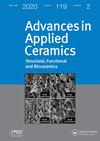Zirconia: as a biocompatible biomaterial used in dental implants
IF 1.6
4区 材料科学
Q3 MATERIALS SCIENCE, CERAMICS
引用次数: 6
Abstract
ABSTRACT Zirconia is a bioinert ceramic biomaterial. Zirconia having composition of 97% Zirconia oxide and 3% Yttria oxide finds its vital application in the field of dental ceramics as an implant material for having good inert characteristics like minimum interaction with the adjacent tissues and exhibits good aesthetic property. This paper presents the in-vitro tests conducted to evaluation toxicity by cell culturing on zirconia biomaterial used in the dental implant by both direct contact and extraction method. In the present study, in-vitro assessment of tissue biocompatibility was conducted on L929 cell line (mouse fibroblast). In-vitro test, the toxicity of Zirconia specimen was done by computing percentage of viability in a cell-cultured medium. An MTT system was used to measure the active cell activities with mitochondrial dehydrogenases, which is an easy method which gives accurate and precision results. The results of biocompatibility in-vitro test by both Direct and Extraction methods confirmed that Zirconia exhibits the highest cell growth of 93.17% and resulted with zero-grade cytotoxicity. Zirconia having good aesthetic characteristics, i.e. colour of the implant matches with the tooth colour. Hence Zirconia is a candidate implant material than other metal implants.氧化锆:作为一种生物相容性生物材料,用于种植牙
氧化锆是一种生物惰性陶瓷生物材料。氧化锆由97%氧化锆和3%氧化钇组成,具有良好的惰性特性,如与邻近组织的相互作用最小,并具有良好的美学性能,在牙科陶瓷领域作为种植材料得到了重要的应用。本文采用直接接触法和提取法对氧化锆生物材料进行体外细胞培养,评价氧化锆生物材料在口腔种植体中的毒性。本研究对L929细胞系(小鼠成纤维细胞)进行了体外组织生物相容性评价。体外实验中,氧化锆试样的毒性是通过计算细胞培养培养基中的活力百分比来完成的。采用MTT系统测定线粒体脱氢酶活性,方法简便,结果准确、精密度高。直接法和萃取法体外生物相容性试验结果表明,氧化锆的细胞生长率最高,为93.17%,细胞毒性为零级。氧化锆具有良好的美学特征,即种植体的颜色与牙齿的颜色相匹配。因此,氧化锆是一种较理想的金属种植材料。
本文章由计算机程序翻译,如有差异,请以英文原文为准。
求助全文
约1分钟内获得全文
求助全文
来源期刊

Advances in Applied Ceramics
工程技术-材料科学:硅酸盐
CiteScore
4.40
自引率
4.50%
发文量
17
审稿时长
5.2 months
期刊介绍:
Advances in Applied Ceramics: Structural, Functional and Bioceramics provides international coverage of high-quality research on functional ceramics, engineering ceramics and bioceramics.
 求助内容:
求助内容: 应助结果提醒方式:
应助结果提醒方式:


